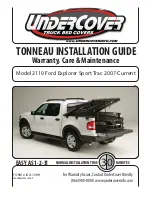
DRIVER SUPPORT
}}
* Option/accessory.
379
Limitations of Park Assist Pilot
*
The Active parking assistance (Park Assist Pilot
– PAP) function may have limitations in certain
situations.
Parking is discontinued
A parking sequence will be discontinued:
•
if the driver moves the steering wheel
•
if the car is driven too quickly - above 7 km/h
(4 mph)
•
if the driver presses
Cancel
in the centre
display
•
when the anti-lock brakes or the Electronic
stability control are engaged - e.g. when a
wheel loses grip on a slippery road.
Where applicable, a message in the centre dis-
play states the reason for a parking sequence
being discontinued.
Dirt, ice and snow covering the sensors will
reduce their function and may prevent meas-
urement.
Under certain circumstances, PAP is unable
to find parking spaces - one reason for this
may be the fact that there is interference with
the sensors from external sound sources
which emit the same ultrasound frequencies
as those with which the system works.
Examples of such sources include horns, wet
tyres on asphalt, pneumatic brakes and
exhaust noises from motorcycles etc.
Driver responsibility
The driver should bear in mind that the PAP is an
aid – not an infallible, fully-automatic function.
The driver must therefore be prepared to inter-
rupt a parking step.
There are also a few details to bear in mind while
parking, e.g.:
•
PAP bases itself on the locations of vehicles
already parked nearby - if they are inap-
propriately parked, your own car's tyres and
wheel rims may be damaged by contact with
the kerb.
•
PAP is designed for parking on straight
streets - not sharp curves or bends. For this
reason, make sure the car is parallel to the
parking space when PAP measures the
space.
•
Parking spaces on narrow streets are not
always feasible, since the space required for
manoeuvring may not be sufficient.
•
Bear in mind that the front of the car may
swing out towards oncoming traffic while
being parked.
•
Objects situated higher than the detection
areas of the sensors are not taken into
account when calculating the parking
manoeuvre. This may cause PAP to turn into
the parking space too early, and hence such
parking spaces should be avoided.
•
The driver is responsible for determining
whether the space selected by PAP is suita-
ble for parking.
•
Use approved tyres
28
with the correct tyre
pressure - this affects the ability of PAP to
park the car.
•
Heavy rain or snow may cause the system to
measure the parking space incorrectly.
•
Do not use PAP if snow chains or a spare
wheel are fitted.
•
Do not use PAP if cargo items are protruding
from the car.
•
Perpendicular parking spaces may be missed
or offered unnecessarily if one parked car is
protruding more than other parked cars.
28
"Approved tyres" refers to tyres of the same type and make as those fitted new on delivery from the factory.
Summary of Contents for V 90 Cross Country
Page 1: ...OWNER S MANUAL...
Page 2: ......
Page 14: ......
Page 15: ...INTRODUCTION...
Page 57: ...SAFETY...
Page 87: ...INSTRUMENTS AND CONTROLS...
Page 182: ......
Page 183: ...CLIMATE CONTROL...
Page 218: ......
Page 219: ...LOADING AND STORAGE...
Page 237: ...LOCKS AND ALARM...
Page 273: ...DRIVER SUPPORT...
Page 384: ......
Page 385: ...STARTING AND DRIVING...
Page 435: ...AUDIO AND MEDIA...
Page 479: ...AUDIO AND MEDIA 477 Country Area Korea B B Taiwan...
Page 483: ...WHEELS AND TYRES...
Page 506: ......
Page 507: ...MAINTENANCE AND SERVICE...
Page 558: ......
Page 559: ...SPECIFICATIONS...
Page 578: ......
Page 592: ...ALPHABETICAL INDEX 590...
Page 593: ......
















































